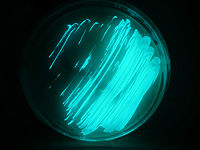Photobacterium phosphoreum
For the course duration, the article is closed to outside editing. Of course you can always leave comments on the discussion page. The anticipated date of course completion is May 21, 2009. One month after that date at the latest, this notice shall be removed. Besides, many other Citizendium articles welcome your collaboration! |
| Photobacterium phosphoreum | ||||||||||||||
|---|---|---|---|---|---|---|---|---|---|---|---|---|---|---|
 | ||||||||||||||
| Scientific classification | ||||||||||||||
| ||||||||||||||
| Binomial name | ||||||||||||||
| Photobacterium phosphoreum |
Description and significance
Photobacterium phosphoreum is a luminescent bacterium. They are gram-negative, straight rod, plump and large (0.8-1.3 um in diameter and 1.8-2.4 um in length). They can be motile or non-motile. Those that are motile have 1-3 unsheathed polar flagella. It can grow at low temperature, 4˚C, but no at 35˚C. They emit the brightest light from all bacteria [1]. Their optimum temperature is 18-25˚C [2]. They emit a blue-green light due to the catalytic activity of luciferase. They are oxidase positive because they can use D-glucose as their principle carbon source (Prescott, Harley and Klein 557). They can be cultivated in Long and Hammer Agar (1% NaCl). It is known as a symbiotic bacterium that lives in the light organ of some marine fishes. It can also live freely in seawater, saprophytically and parasitically [3].
Their major significance is their symbiotic relationship with some marine animals like fishes and squids. They have light organs that provide P. phosphoreum microorganisms with a safe place to inhabit and food; while these animals use the light that the bacteria provide for camouflage, communication and even for attracting mates or escape from predators Only opens in QC. Light emission can also aid to the propagation of the host. Another role that P. phosphoreum has is their ability of signaling the relative toxicity of a substance. This can happen due to the connection of the light producing process with the cellular metabolism. If the toxins disrupt the cellular metabolism, then the strength of the light produced decreases [4].
Genome structure
Cell structure and metabolism
P. phosphoreum belongs to the phylum Proteobacteria. All bacteria that belong to that phylum are known to be Gram-negative. As gram-negative P. phosphoreum contain an outer membrane made of lipopolysaccharide outside and inside phospholipids, a periplasma space, a thin peptidoglycan layer and finally the plasma membrane Encyclopedia of Life Sciences.
P. phosphoreum is a chemoorganotroph which is capable of respiratory and fermentative metabolism [5]. It is a facultative anaerobe that can grow in the absence of oxygen when appropriate electron-acceptors are present. It doesn’t denitrify; in other word, it cannot use nitrogen molecules [6].
P. phosphoreum can produce blue-green light with the help of an enzyme called luciferase. “Luciferase catalyzes the reaction and uses reduced flavin mononucleotide, molecular oxygen, and a long-chain aldehyde as substrate” (Prescott, Harley and Klein 559).
Equation
FMNH2 + O2 + RCHO + luciferase → FMH + H2 + RCOOH + light
When the excited flavin intermediate (FMN) moves to ground state, it emits the light which is one of the products of the reaction [7]. "The bioluminescence quantum yield has been estimated to be 10–30%" Encyclopedia of Life Sciences. If you have observed in the photosynthetic equation reaction, oxygen is not produce therefore P. phosphoreum is known to have an anoxygenic photosynthesis Encyclopedia of Life Sciences.
Ecology
P. phosphoreum is mostly considered a marine bacterium because sodium ions are required for its growth. It lives in the depth of the ocean, seawater, marine sediments, in the guts of marine animals, and on the surface of decomposing fish. When they are dispersed they produce a very weak light; however when they are very close to each other they produce light efficiently. P. phosphoreum acts as the light bulb in the in a dark environment like in the depth of the ocean Biology.
Application to Biotechnology
Luciferase is used in biotechnology processes. P.phosphoreum posses in its chromosomes the lux gene which code for this enzyme.
Current Research
References
http://www.ncbi.nlm.nih.gov/Taxonomy/Browser/wwwtax.cgi?id=659
http://www.microbiologyatlas.kvl.dk/biologi/english/showmorf.asp?articleid=44
http://www.disknet.com/indiana_biolab/b203.htm
http://www.biology.pl/bakterie_sw/index_en.html
http://cibt.bio.cornell.edu/programs/archive/0608alum/lumos.pdf
http://web.mst.edu/~microbio/BIO221_2005/P_phosphoreum.htm
http://www.microbelibrary.org/ASMOnly/Details.asp?ID=552
Willey, Joanne, Linda Sherwood and Christopher Woolverton. Prescott, Harley, and Klein's Microbiology. 7th ed. New York: New York, 2008.
http://mrw.interscience.wiley.com/emrw/9780470015902/els/article/a0003064/current/html